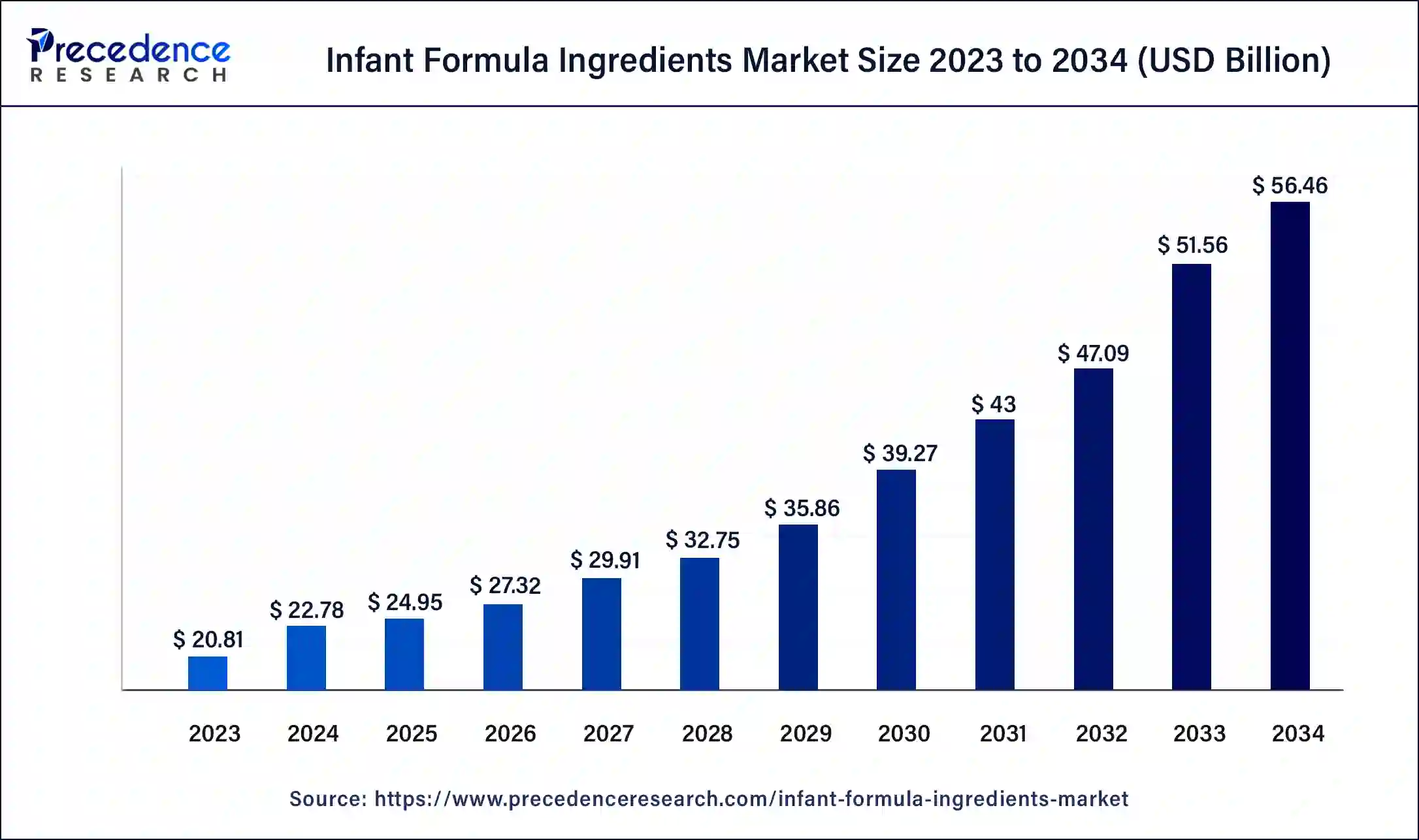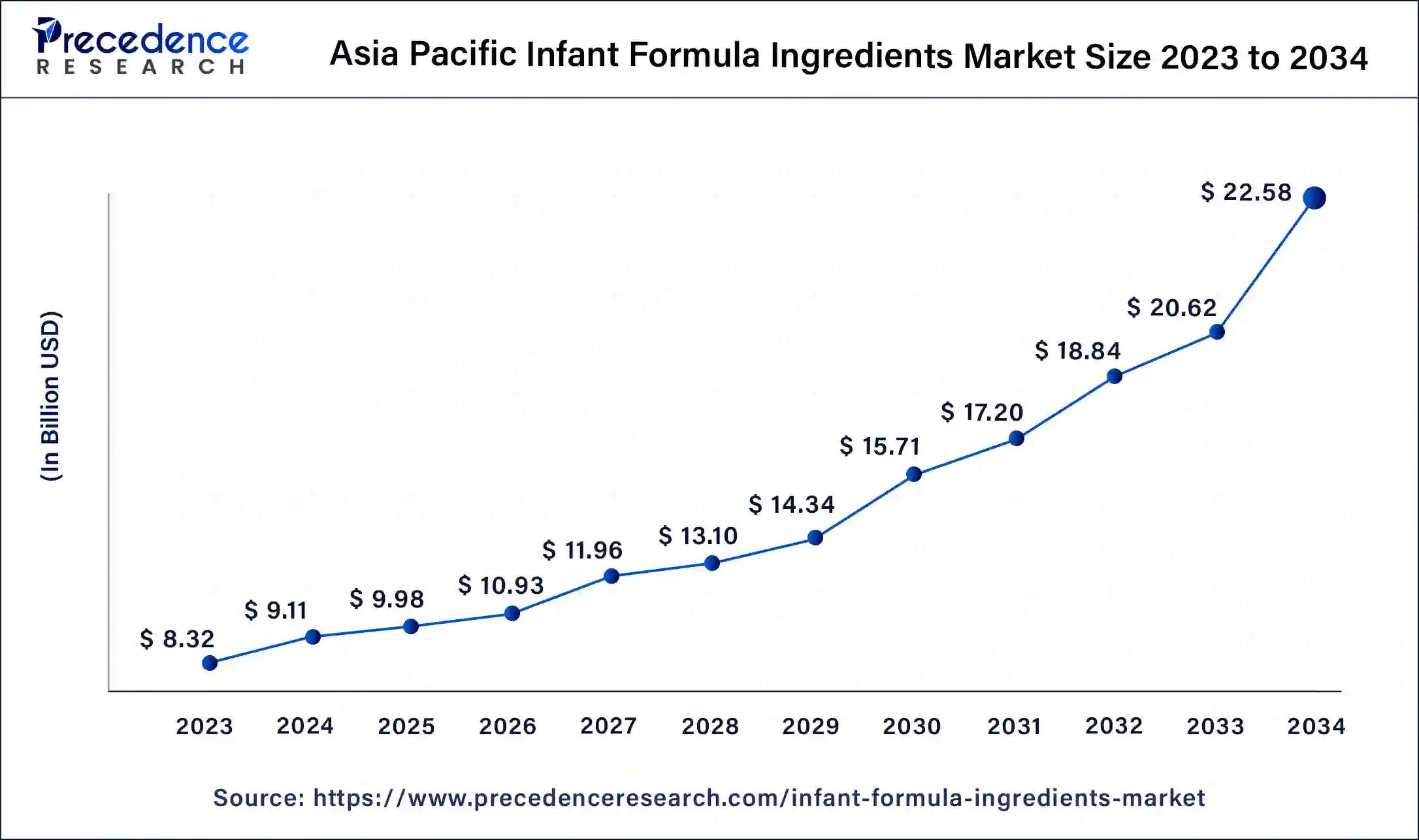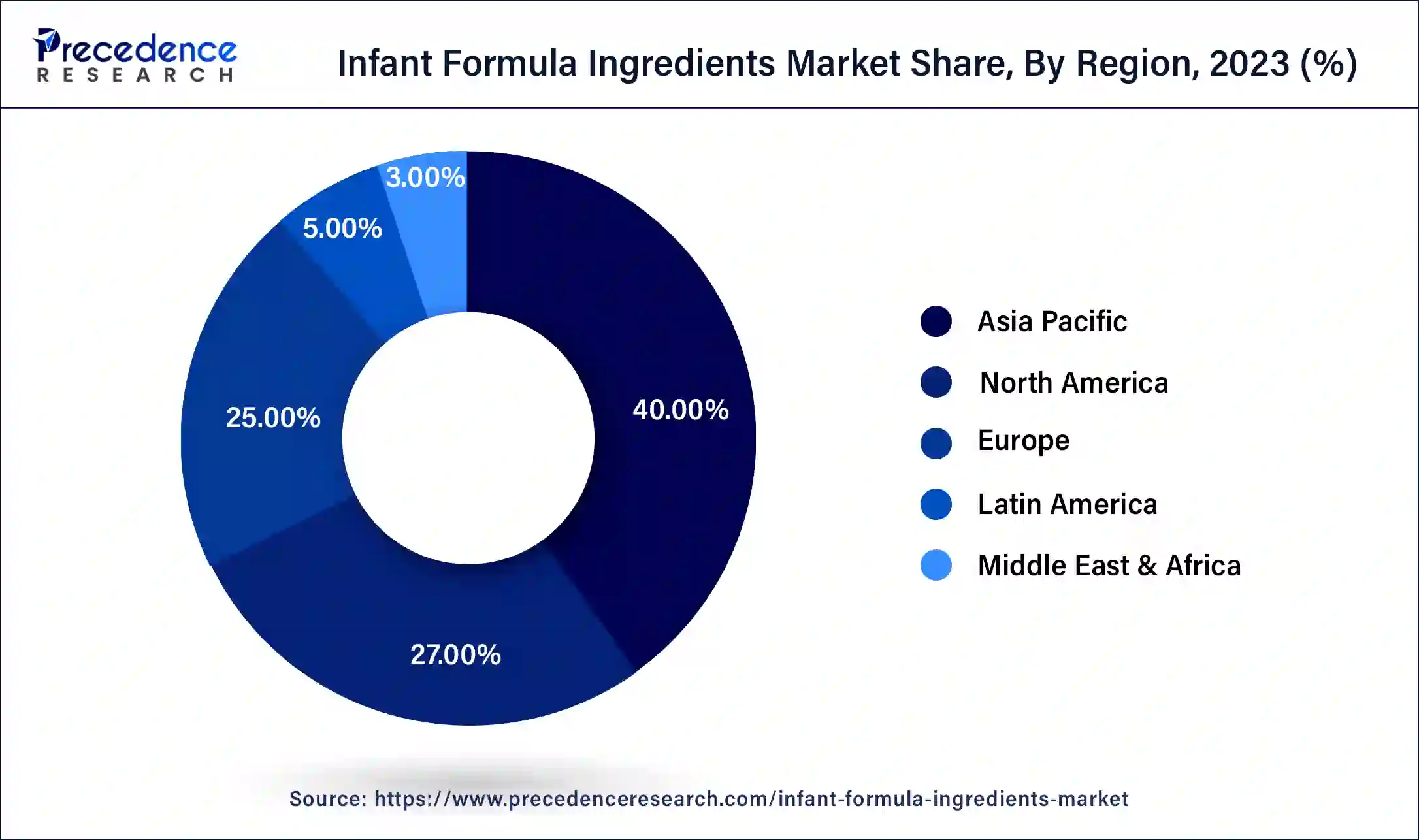April 2023
Infant Formula Ingredients Market (By Type: Infant Milk Formula, Follow-on Milk, Others; By Distribution Channel: Hypermarkets, Supermarkets, Pharmacy, Medical Store, Specialty Store, Others) - Global Industry Analysis, Size, Share, Growth, Trends, Regional Outlook, and Forecast 2024-2034
The global infant formula ingredients market size was USD 20.81 billion in 2023, accounted for USD 22.78 billion in 2024, and is expected to reach around USD 56.46 billion by 2034, expanding at a CAGR of 9.5% from 2024 to 2034.

The Asia Pacific infant formula ingredients market size was estimated at USD 8.32 billion in 2023 and is predicted to be worth around USD 22.58 billion by 2034, at a CAGR of 9.7% from 2024 to 2034.

The Asia Pacific region held the highest revenue share of more than 40% in 2023. The developing countries belonging to this region help to boost the market on account of the number of working females residing in this area. Countries like China who have abolished the system of one child and have opted for increasing the population which has shown a positive impact on the sales and supply of formulated food products.
The reason of South Africa and the Middle East have also experienced an increase in the demand of formula food products for infants as a result of the rising female working population. The increasing health awareness among people has also led to a surge in demand for these formula products. The increasing craze for the Western lifestyle and the shift to it has help to strengthen the market growth in these regions. The rising economy of the developing nations has proved to be a boon for the market during the forecast period.

Market Overview
Infant formula food is a product that takes care of the nutrition of an infant during its growing years. It mainly concentrates on providing all the vitamins and minerals along with the rare ones in the correct quantities required for the body of the infant at that particular age. Trick rules and regulations have been devise by the government and various other bodies such as the FSSAI and WHO, which have a separate set of guidelines regarding these food products for the younger age groups in order to maintain their health and immunity. During recent research, various conditions have come up where individual infants was intolerant to lactose. For such conditions, lactose-free formulated food was developed by taking special care regarding the intolerant behavior of the body.
Pertaining to the lack of nutritious food consumed by pregnant female and the other developmental disorders taking place during pregnancy the rate of premature births have increased to a great extent. This development has been dealt with the help of premature infant milk substitutes that are mainly formulated to take care of the lakh in nutrients suffered by the body of the infant and does help it to develop correctly before major pathological changes take place. The increase in the number of cases of malnutrition among infants has encouraged the market to produce formula foods for special medical conditions where the required need for nutrition is fulfilled to develop the health of the infants and lead a normal life.
The outbreak of the pandemic could not make a significant decline in the market owing to the constant demand for formulated food products for infants. However, the supply chain of the formulated products was hampered to a certain extent because of the strict lockdowns that were imposed in certain regions of the world in order to restrict the spread of infection. The increasing awareness regarding the development of infants has helped the market to grow over a period of time. The guardians of the infants have opted for additional foods in order to avoid the deficiencies caused due to lack of nutritive food products. This disruption in the demand and supply chain in the market had put a negative effect on the overall growth of the industry.
The high cost associated with these formulated food products has hampered the growth of the market during the forecast period. The lower socio-economic group is not very comfortable purchasing these costly formulated food products. The developing and underdeveloped countries hence do not show significant growth in the market for these food products. On the other hand, developed countries are showing significant growth in the market for formulated food. Increasing the basic body construction is taken into consideration in the long-term use of the formulated food products hampers the growth of the child due to the presence of preservatives in these products. It makes the infant dependent on such food products and the affinity towards the normal nutritious food is hampered. Also, a number of pathological changes take place inside the body due to the long-term use of these formulated products.
The rapid research and development which is carried out by the market leaders in order to boost the market for the formatted food products has helped to increase in the revenue. The promises made regarding the fulfillment of the nutrition required by the body of the infant is a potent marketing strategy used by the market players. The early shift to a formulated food product act as a breast milk substitute in the developing period of the infant. As a result, the fertility rate in the world has been propelled considerably. According to the developing lifestyle of the people the dependence on formulated food products has increased, pertaining to the increased workload of the guardians and busy lifestyle. The rapid urbanization of the world has also helped to boost the market due to increasing dependence on substitutes instead of the traditional ways of breastfeeding. The heavy investments made by the market leaders in order to popularize the formulated food products have also been a great driving factor for increasing the revenue of the market. The recent developments of innovative products are also proving to be a driving factor for the current market.
The rise in the modern lifestyle has led to a growing number of females in the current generation. Additionally, the unsupportive work culture of the companies forces the guardians to switch to formula food products in order to fulfill the nutrition requirements of the child without investing much time into their food habits. The increase in the number of females going for work has given rise to the disposable income capacity of the people which makes them capable to purchase formula food products and other artificially packed nutritive supplements. The unavailability of a supportive system and of a qualified lactation expert has encouraged the guardians to shift to formula food products instead of traditional breastfeeding techniques. The lack of nutrition among the infant group has helped the market to show a considerable increase in revenue as it has promised to fulfill this void. The rise in the number of medications available for increasing lactation has made in people averse to opt for such treatments.
Additionally, the medical fraternity has also helped to boost the market for formula-based products by making it as a compulsory post-delivery protocol to be followed by the lactating mother for the development of the infant. According to the statistics the number of lactating females performing breastfeeding for their infants is sub-optimal in comparison to the normal ranges which are expected to take place. A huge number of breast-feeding mothers voluntarily choose formula product foods over the traditional pattern of breastfeeding to have an is your lifestyle and to avoid the hard work which lies behind planning and feeding nutritive meals to their children. These multiple factors which are supported by the modern attitude of the breastfeeding mothers, the uncompromised lifestyle of the working females, non-cooperative work environment delivered by the companies, promise Singh product quality of the formula food manufacturers, voluntary backup provided by the medical fraternity to the formula food industry, increasing research and development in order to manufacture better quality products and the government support help the formula food products market to boost during the forecast period.
| Report Coverage | Details |
| Market Size in 2023 | USD 20.81 Billion |
| Market Size in 2024 | USD 22.78 Billion |
| Market Size by 2034 | USD 56.46 Billion |
| Growth Rate from 2024 to 2034 | CAGR of 9.5% |
| Base Year | 2023 |
| Forecast Period | 2024 to 2034 |
| Segments Covered | By Type, and By Distribution Channel |
| Regions Covered | North America, Europe, Asia-Pacific, Latin America, and Middle East & Africa |
Drivers
The nutrition requirement of an infant is the primary focus of a guardian which cannot be neglected at any cost. Hence the formula food market experience is tremendous growth in developing and underdeveloped nations where there is a huge walking class of people who are lactating and breastfeeding mothers. Moreover, as a result of the busy lifestyle that people have opted for, there is very little time existing for the preparation of a nutritious meal for the infant. Hence the guardian opts for early weaning for the infant resulting in an increased share of infant formula food products. The medical fraternity has openly supported the use of formula-based products to maintain the nutrition of premature and underdeveloped infants. In order to avoid the risk of malnutrition among infants the use of formula-based products is encouraged so that the entire package of Nutrition is provided at one go without any chances of failure. This has helped to reduce the rate of malnutrition to a great extent.
Restraints
The cost of formulated food products for infants is very high. As a result of this the population belonging to developing nations and underdeveloped countries cannot afford it for a long period of time. They constantly wait to shift to the local alternative which hampers sales in the long run and thus the market declines in these regions. The expenses over these formulated food products impose an additional load over the disposable income of the people. Hence a drop in sales becomes a restraining factor for the market. Artificial food products contain a number of preservatives that hampers the health of infants in the long run. Lack of appetite and constant habit of formulated food products makes the child averse to common local food products which hamper the immunity of the child. This becomes a great concern for the market owing to the increasing awareness about health in this post covid phase of the market. The outbreak of the pandemic did not have a significant impact on the infant formula food products market but has reduced the supply chain owing to the constant lockdowns and restricted movement of people.
Opportunities
The increasing number of working females has reduced the time the mother can devote to their infants. This has turned out to be a great opportunity for the market. The guardians tend to shift to the weaning phase at an early period which results in the adoption of various formula-based food products. The adoption of milk-based food products helps to make the child or infant feel a satisfied stomach which keeps them calm. It also supplies the infant with all the essential nutrients that are required for the overall development of the body at their particular age which has not been fulfilled by the regular diet that is provided to them on the daily basis. These multiple factors have proved to be great opportunities for the market during the forecast period.
Challenges
The Increasing Demand For Natural And Healthy Food Products Has Declined The Market For Formula-Based Food Products. The Occurrence Of The Pandemic Had Created An Awareness Among The People Regarding The Side Effects Of Preservatives And The Negative Influence It Has On The Immune System Of The Individual. This Has Hampered The Sales Of The Artificial Formula Food Products Which Contain Food Grade Preservatives In Them To Help It To Remain Edible For A Longer Period Of Time. The High Cost Of The Food Product For Infants Has Imposed A Burden Over The People Belonging To The Lower Socioeconomic Class. As A Result, Not Many People Can Contribute To The Growth Of The Industry. Various Health Problems Created By The Formula Food Products In The Digestive System Of The Infants Have Become A Challenge For The Growth Of The Market. These Multiple Factors Have Hampered The Growth And Challenged The Revenue Returns Of The Market During The Forecast Period.
Type Insights
The milk formula which has been specially designed for infants has seen tremendous growth during the forecast period. It has seen a potential value-based sale and helped the market to make a strong foothold. There are not many variations available to the guardians regarding formula foods and products. Milk being a basic food product that can be fed to the newborn helps the market to make its place easily. The presence of micronutrients such as iron calcium carbohydrates and proteins help to make an easy shift from traditional breastfeeding techniques to formula food products. Thus, the basic nutrient requirement of the infant is met with easily without compromising the professional life of the mother. There is a lack of nutrition provided to the infant during the weaning period which is fulfilled with the help of formula food products.
Distribution Channel Insights
The vast availability of formulated food products for infants as a result of the rapid organization has helped to boost the market availability of formula foods in hypermarkets and supermarkets increasing their sales rapidly. The multiple offers and schemes put up by the superstores in order to boost the sales of these products help to increase the revenue of the company. The presence of a specialist who helps the customers who choose the least formula food products helps the consumer to gain confidence in experimenting with them for their infants.
The other outlets which help to boost the market are pharmacies, medical stores, and other such small-scale outlets. These small outlets provide the actual business which is unseen due to their small size but make great sales as they are providing the regular consumers on a daily basis. The presence of a variety of baby products along with their nutritional supplements under one roof helps to boost the market for formula food products to a great extent during the forecast period.
Recent Developments
Segments Covered in the Report
By Type
By Distribution Channel
By Geography
For inquiries regarding discounts, bulk purchases, or customization requests, please contact us at sales@precedenceresearch.com
No cookie-cutter, only authentic analysis – take the 1st step to become a Precedence Research client
April 2023
November 2024
March 2025
December 2024